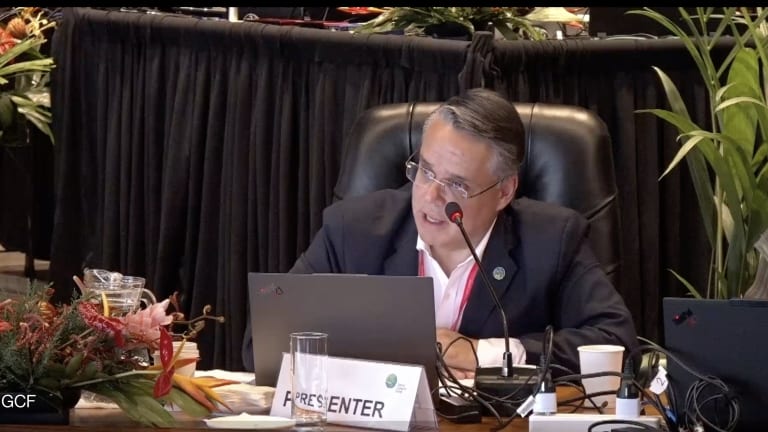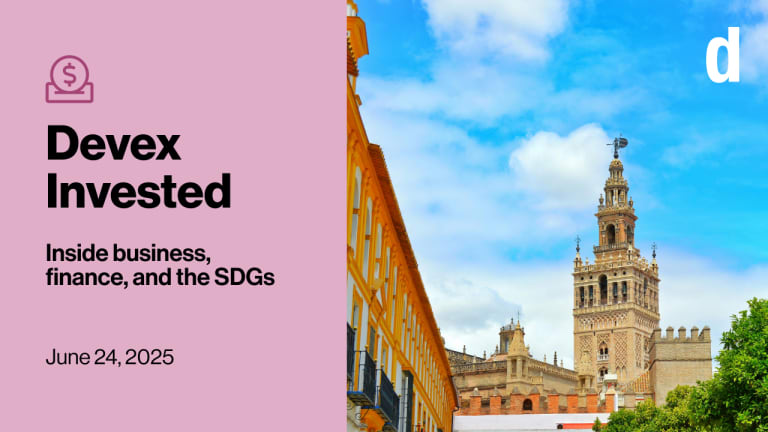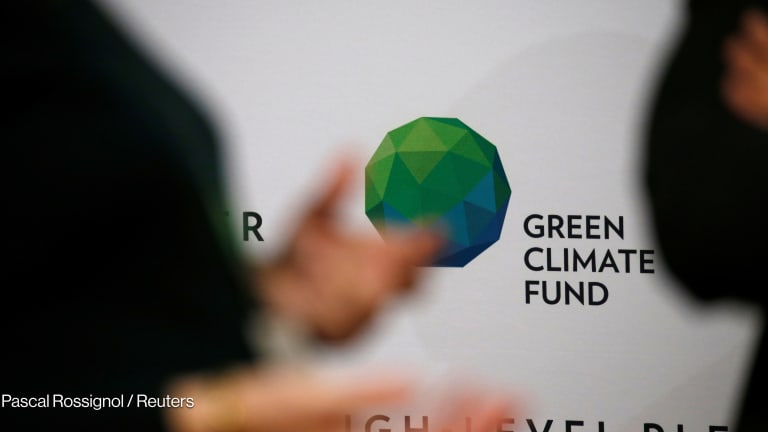MDB climate finance hit a record in 2023. Where is the money going?
Global climate finance reached a record $125B in 2023, a year of unprecedented high temperatures and increasingly volatile weather patterns. But where is this money going? And what does this figure mean for COP 29 discussions?
Global climate finance reached a record high of $125 billion in 2023, according to the latest Joint Report on Multinational Development Banks’ Climate Finance report published on Sept. 20 — a 25% increase from $99.7 billion in 2022. The report comes on the heels of the hottest year on record with the highest number of climate disasters yet. Climate-related deaths globally hit 12,000, according to the international disaster database. The United States alone experienced more than $92.9 billion in damages and 492 deaths from climate and weather disasters. In 2022, the world surpassed its $100 billion per year financing target — established in 2009 — for the first time. But COP 29, the United Nations Climate Change Conference to be held in Azerbaijan in November, is expected to produce an updated climate finance target for donor countries, known as the new collective quantified goal, or NCGQ. Parties have agreed that the new target must surpass $100 billion and be focused on the needs and priorities of low- and middle-income countries, but experts don’t yet know much more than that. Where is the money going? The financing comes from a combination of 10 multilateral development banks’ own accounts and external resources that are run by them. This includes trust funds, bilateral agencies, or climate-specific funds, such as the Climate Investment Funds or The Green Climate Fund. The $125 billion encompasses financing to high-income economies as well as low- and middle-income countries. In total, $74.7 billion went to low- and middle-income countries in 2023, up from $60.9 billion in 2022. High-income countries received $50.3 billion, up from $38.2 billion in 2022. The funding went to both mitigation, which is meant to reduce the impacts of climate change through decarbonization measures, and adaptation, which helps communities, governments, and individuals become more resilient to the impacts. Of the money received by low- and middle-income countries, $50 billion — or 67% of the total — was for climate change mitigation finance. The other $24.7 billion, or 33%, was targeted at adaptation. The majority of the adaptation funds went to sub-Saharan Africa, while the majority of the mitigation funds went to Latin America and the Caribbean. The highest percentage for both adaptation and mitigation was used for energy-related issues. Most of the funding to low- and middle-income countries — 65% — was done through investment loans, which include concessional loans, grants to governments, insurance and risk instruments, and private sector and public institutional support, among others. But in all cases, it requires that the funding is repaid. For high-income countries, $47.3 billion, or 94%, went to climate change mitigation finance, and $3 billion, or just 6%, went to adaptation. It’s difficult to draw any clear conclusions about why this discrepancy in adaptation funding between low- to middle-income countries and high-income countries exists because high-income financing is dominated by one bank: the European Investment Bank, according to Harry Boyd-Carpenter, managing director of climate strategy and delivery at the European Bank for Reconstruction and Development. The majority of EIB’s recipients are countries in Western Europe. “We happen to operate in a lot of high-income countries,” said Nancy Saich, EIB’s chief climate change expert and group chair for the 2023 report. “But all of those investments in climate finance are important because if the developed world doesn’t continue to decarbonize its energy systems and stop emitting, then we’re not addressing climate change in a global way.” Institutions that operate in both low- to middle-income and high-income countries generally lean toward mitigation because the outcomes are tangible products that usually provide a return on investment. Mitigation is also easier to replicate and scale. Adaptation projects, on the other hand, are usually case and location-specific, small-scale, and often a component of a larger project. Adaptation tends to trail behind mitigation no matter a nation’s level of prosperity, according to Saich. “It’s a global issue. Everybody needs to do more on investment in adaptation finance,” she said, adding that EIB is working on boosting its adaptation investments. How will this affect COP 29 discussions? The $125 billion figure is not representative of the United Nations funding target because it only includes MDB funding — which goes to high-, medium-, and low-income countries. The U.N. target, on the other hand, focuses on how much funding is flowing from the global north to the global south. “You can’t just extrapolate from the numbers that we used in this report and plug that into the $100 billion,” said Boyd-Carpenter. However, the data does provide a reference point for the discussions, because each country that contributes to an MDB can include their share of whatever that MDB is allotting to low- and middle-income countries into their own climate accounting. “This MDB report and its underlying data is a very important and transparent part of what is needed for the calculations on how we are doing on the $100 billion target,” said Saich. “Obviously we don’t know how the negotiations will come out at COP 29, but we do know that it has to be more than $100 billion,” she added. “So what we do is we provide our information as transparently as possible.” Methodology The methodology for tracking climate adaptation finance involves three steps: identifying vulnerability, stating the intention to address the vulnerability as part of the project, and articulating a direct link between that vulnerability and specific project activities. Adaptation can be very difficult to track, according to Saich. “There aren’t obvious types of investments that you get for mitigation, such as renewable energy, electric public transport, energy efficiency,” she said. “[Adaptation efforts are] also usually part of a bigger project.” Saich added that there are many more steps involved in the actual assessment of adaptation projects than the three listed above. “Most of us have quite intensive guidance and methodology training to assess projects,” she said. “But there is no magic solution to just saying well, we count this much here and that much there. They’re all different.” For mitigation, the methodology works differently. The finance has to fall within a list of eligible activities. This could be negative or low-emission activities, activities that help an economy shift away from high emissions, or activities that enable the transition to lower emissions, such as low-emission technologies. MDBs are working to refine technologies for finance tracking, according to Nadya Myasnikova, principal of green financial systems in climate strategy and delivery at EBRD. But some experts say that the accounting process can be resource intensive. “We try to be quite scrupulous. We have layers within the bank where some people take a look at projects who are not directly incentivized to achieve it, so they have a degree of distance,” said Boyd-Carpenter. “But you can spend a lot of time worrying about exactly how to count, however, all that resource is resource you don’t spend actually making an impact on the ground. So we’re always trying to strike a balance.” Institutional focus The record number in the report reflects a general trend among MDBs towards climate change and climate finance. In April, the World Bank Group said it was “ramping up its climate action with new measures.” The group said it is dedicating 45% of its annual financing to climate change and adaptation by 2025. Last week, the World Bank also announced that it, in partnership with the African Development Bank, will connect 250 million people on the African continent to electricity through its “Mission 300” plan. Climate financing across MDBs tripled between 2013 and 2021, according to a report by the ODI think tank. However, the report mentions that the increase is partly due to changes in reporting. ODI tried to harmonize the reports to minimize any double-counting between mitigation and adaptation flows. In August, the Asian Development Bank announced plans to dedicate 50% of its annual lending to climate finance by 2030. The Asian Infrastructure Investment Bank also created a new financing option that will help advance the implementation of its Climate Action Plan. EBRD announced its intention to become a “majority green bank by 2025.” “MDBs have scaled up their delivery and shown that they are equipped to respond to the external pressure,” said Boyd-Carpenter. “I think there’s a general feeling that there are an awful lot of institutions out there and we don’t need a new one,” he said. “What we need is for the existing ones to keep doing more and more.”
Global climate finance reached a record high of $125 billion in 2023, according to the latest Joint Report on Multinational Development Banks’ Climate Finance report published on Sept. 20 — a 25% increase from $99.7 billion in 2022.
The report comes on the heels of the hottest year on record with the highest number of climate disasters yet. Climate-related deaths globally hit 12,000, according to the international disaster database. The United States alone experienced more than $92.9 billion in damages and 492 deaths from climate and weather disasters.
In 2022, the world surpassed its $100 billion per year financing target — established in 2009 — for the first time. But COP 29, the United Nations Climate Change Conference to be held in Azerbaijan in November, is expected to produce an updated climate finance target for donor countries, known as the new collective quantified goal, or NCGQ. Parties have agreed that the new target must surpass $100 billion and be focused on the needs and priorities of low- and middle-income countries, but experts don’t yet know much more than that.
This story is forDevex Promembers
Unlock this story now with a 15-day free trial of Devex Pro.
With a Devex Pro subscription you'll get access to deeper analysis and exclusive insights from our reporters and analysts.
Start my free trialRequest a group subscription Printing articles to share with others is a breach of our terms and conditions and copyright policy. Please use the sharing options on the left side of the article. Devex Pro members may share up to 10 articles per month using the Pro share tool ( ).
Jesse Chase-Lubitz covers climate change and multilateral development banks for Devex. She previously worked at Nature Magazine, where she received a Pulitzer grant for an investigation into land reclamation. She has written for outlets such as Al Jazeera, Bloomberg, the Organized Crime and Corruption Reporting Project, and The Japan Times, among others. Jesse holds a master’s degree in Environmental Policy and Regulation from the London School of Economics.








